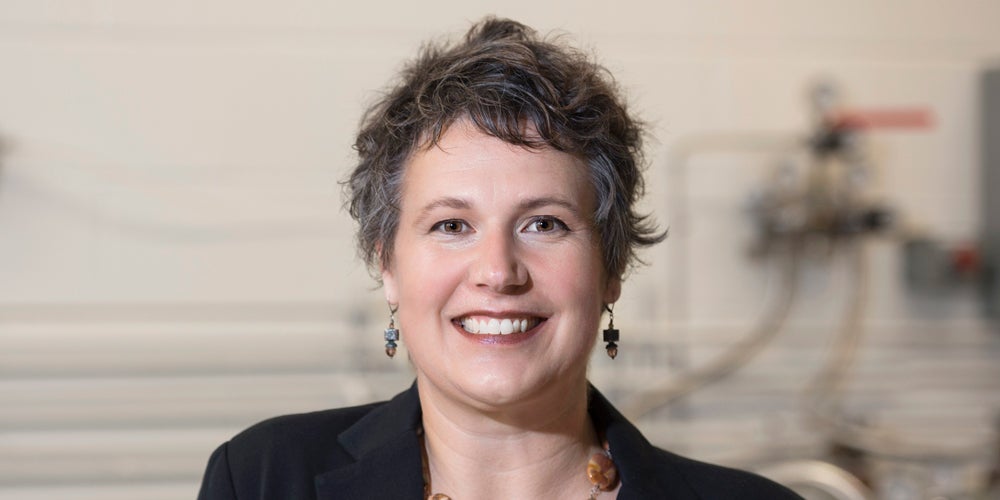Building a Bridge for Water Research
“I think water is one of the things that unites all humans; we all need water, and we all relate to it very intimately,” says Emily Elliott, a professor in the Dietrich School’s Department of Geology and Environmental Science. Elliott and her colleagues recently established the Pittsburgh Water Collaboratory, a platform that helps University of Pittsburgh researchers interact with people across the region to address water issues.
Elliott grew up on the shores of the Chesapeake Bay, aware of the nutrient pollution that burdened the oyster and crab fisheries there. Upon joining the Dietrich School faculty, Elliott became aware of the unique, complex and difficult water challenges faced by the Pittsburgh area. Elliott’s research program focuses on nutrients like nitrogen and phosphorous, so she wanted to develop a platform that she and other researchers could use to learn from and share knowledge with others in the community.
“I found it really difficult as a researcher to integrate myself into the regional community of water practitioners, or stakeholders, who were working on these issues, and other faculty had the same experience,” explains Elliott. She and Dietrich School partners Daniel Bain, Eitan Shelef and Brian Thomas (now at Newcastle University in the UK) worked together to build the Pittsburgh Water Collaboratory.
“We were all having these difficulties, and at the same time what I experienced in the 12 years that I was here was that my graduate students were going through the system, publishing papers, doing high-quality research, but not having any sort of social impact,” says Elliott. “It’s one thing to publish in a prestigious journal, but it’s another thing to translate those research findings and to work with the folks that could be using the information to make things better.”
“That link for the graduate students was really missing,” Elliott says. Now, the Collaboratory, which pairs graduate students with community partners to address specific research questions, is “something that is really adding value to their graduate education.”
As a bridge between academics and the broader community, the Pittsburgh Water Collaboratory facilitates community engagement that helps researchers understand and address the research needs and knowledge gaps in the region.
According to Elliott, more than 100 organizations have a hand in water affairs in Western Pennsylvania, all with valuable insights into what the issues are and how to manage them. Upon inception, the Collaboratory approached more than 300 stakeholders from these organizations that have been working with these issues for decades and asked, “What have you learned, what do we need to do next, [and] what do you see as the key blockages in terms of moving forward?” says Elliott.
“We held a series of three community meetings where we invited those 300-plus stakeholders representing over 100 organizations, and we solicited information sharing from all of these folks on three different issues: One was storm-water management, another was water quality, and the other was flooding. We asked them to help us understand what the knowledge gaps were and what are the best approaches to addressing those knowledge gaps,” Elliott offers. “We got a lot of great feedback.”
The information gained from these meetings was documented in white papers that are now published on Pitt’s DOI and available for download. These papers are important and powerful, says Elliott because, “This is what not just the researchers at Pitt think is important, this is what the water community writ large thinks is important.”
Armed with information, the collaborative is planning future meetings to map out new projects and identify ways to address the issues that were raised. For example, access to data was a frequently cited issue during the meetings.
“Either that the data didn’t exist to evaluate whether something was a problem … or that the data were spread all over the place or not shared,” says Elliott. “As a result of those conversations, we’ve been working with 3 Rivers Wet Weather, which is very interested in being the hub for that activity and the central clearinghouse for that.”
Interactions like these are what the Collaboratory is designed to support. The connection between the University and community leads to collaborative, mutually beneficial problem-solving.
“Just having the community come together and acknowledge that this was a problem that needed to be addressed really allowed this stakeholder to step up and say ‘We can do that—that’s what we’re here for. Let’s do it,’” says Elliott.
In the future, the Collaboratory will expand its reach into local communities and across the University. “In the coming year we’ve been really excited about the opportunities that have presented themselves with the Homewood community engagement center and Pitt’s focus on community engagement,” says Elliott. The Collaboratory hopes to work with Homewood residents to perform research on sewer-backup issues.
In addition to expanding into the community, Elliott says there is a lot of value in having researchers from across the University contribute to the Collaboratory’s efforts.
“It’s really interesting to bring folks from different disciplines to talk about it because there’s such a wide variety of expertise at Pitt,” she says, adding that “all interested faculty, researchers and grad students are invited to become affiliates of the Collaboratory.”
While still in its early stages of development, the Collaboratory has significantly impacted community outreach and graduate education and serves as a model for what funding agencies like the National Science Foundation encourage as broader impacts of research.
“Instead of going into a community and saying, ‘this is what you need to do,’ rather, going in and working with the community to produce knowledge together. It’s a totally different sort of approach but it’s becoming increasingly recognized and a little bit more common,” says Elliott.
“The ultimate goal is for Pitt to be a strong presence in the regional water challenges that we’re facing. Whether it’s combined sewer overflows, acid mine drainage, oil and gas production, or flooding, we have a lot of expertise that can be applied to these issues across the University.”

